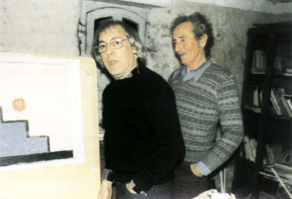 Eduardo Luiz and António Dacosta.
Photograph by Manuel de Brito.
Eduardo Luiz and António Dacosta.
Photograph by Manuel de Brito.
THIS IS SO MUCH LESS A PIPE AS MAYBE PIPES ARE NONEXISTENT... Richard Alewyn wrote in L'Univers du Baroque1 (The Baroque Universe): "No era had a more intense consciousness of the dividing abyss between the material and the unreal worlds than the Baroque. And because of that, the Baroque is not concerned about being deliberately misleading about the difference between the illusive and the real worlds. Above all it reiterates the dissimulation of the crossing moment of that border between the two realms. It aims at precisely leaving the observer drifting in doubt if one is still perceiving tridimentional space or if one's vision has already transposed onto the bidimentionality of illusiveness. It implicitly conveys the supposition of looking at a tangible world when one's sight is already exploring an intangible territory, and it infers that one should never relinquish questioning if one is already 'there' when, in fact, one is still very much 'here'."
It is curious that in what was our era of generalized scepticism, that it was finally found, thanks to persistent critical appraisal, the fundamental ambiguity of Baroque art. For instance, it is cinematically 'correct' to break the unfolding of a dramatic plot — preferably in exact moments of greatest tensions — with clips showing the film's technical crew in action or having a rest. In pictorial hyper-realism the same happens. For instance, Malcolm Morley after reproducing to the outmost detail, a photograph depicting a horse race in South Africa, splashed over it a large red cross. Exegetes claim that the artist's intention was to overstate the bidimentionality of the painting as well as to cancel all possible excitement from the figuratively depicted anecdote. If so; why was so much effort invested just to represent that pun? Beyond all possible interpretative hypothesis, I cannot avoid feeling that, deep down, a terrible sense of uneasiness transpires from the work. In order to make this point clearer, it is now important to analyse the paintings of Eduardo Luiz. It is well worth it. In most cases, with a cold virtuosity which undoubtedly veils a particularly violent passion, Eduardo Luiz contextualizes objects by negating them.
If his approach, deliberately addressing 'art history', belongs to another era, his problematic is absolutely updated, if only explicited by his continuously symbolic, expressive and oneiric denials. Besides, his constant return to all pertaining to the realm of conventionally classified and/or catalogued ornamentation — such as frames with rounded corners —, and to the pure 'Orphic' eloquence — in Apollinaire's interpretative sense — of circles, ovals, ribbons, and bandings, contributes to reinforce and emphasise effects of withdrawn and rupture.
Why then, do his paintings inflict to their viewers a sense of vertigo and spell? Inteligence, even if 'critical' — according to present fashions — does not hold such powers. I am tempted to say that the gravitational pull — or pull-push — is here directly linked to what is hidden, and/or to what has been withdrawn or severed. In other words, what has not been 'voiced' is that which singularly 'echoes' in silence. The problem thus consists in ascertaining what is Eduardo Luiz simultaneously hidding from the viewer and somehow expliciting to the viewer. I regret if my answer to this is exceedingly banal, but I remain convinced that what the artist simultaneously hides and reveals in his works is the reality of death. And that "the crossing moment of that border" that the Portuguese painter veils is not the bridging between the 'here' and the 'there' of Baroque artists, but the connections between life and death, between existence and void.
It remains true that despite such differences the conclusion that, according to Richard Alewyn, was valid for those artists is equally valid for Eduardo Luiz: "If it is impossible to know where reality ends and illusion begins then, the reality of the world as such is open to doubt." It is interesting to note that in Eduardo Luiz the reality of death is explicited — or disguised — through a female reality. And I cannot avoid sensing in that magnificent and mysterious painting entitled The Woman of the Vegetarian Butcher (Au Boucher Végétarien) a feeling related to the emblematic destruction — the ritual assassination — of women. We are all familiar with the prosecution records: by the unconsiderative use of their sex — here, an open melon, elsewhere, a pomegranate —, women not only castrate — forever imprisioning our sexuality to theirs — taking revenge for their own castration, but, above all, give life to men — thus condemning them to death. It would be impossible to be exccessively harsh...
In no other painting that spell, concomitantly dreaded and desired, provoked by the female sex —threshold of the forbidden, and antichamber of death — is so admirably and simply tranposed as in Occultation (Occultation): a plain white curtain embroidered at the bottom split open against sheer darkness. I hope not to displease Eduardo Luiz implying that the pivotal thematic of his paintings is that obcession that all men — I mean, all human beings of the masculine gender — share, in a more or less confusing manner. He should be confered with the merit — common to most artists — of transforming an obsession into a reflective contemplation 'legible' by all. A reflection enunciated in beauty terms such as splendorously tonal flesh, contoured vegetables, textured textiles, and all the pleasures of touch transposed to the domain of perception. Inasmuch as to paint the realities of this world — even if questionable — is to doubly experience them, it can be concluded that, in a certain way THIS IS SO MUCH MORE A PIPE AS MAYBE PIPES DO EXIST.
NOTES
1 ALEWYN, Richard, L'Univers du Baroque, (Bibliothèque Médiations), Paris, Editions Gauthier, 1964.
start p. 141
end p.